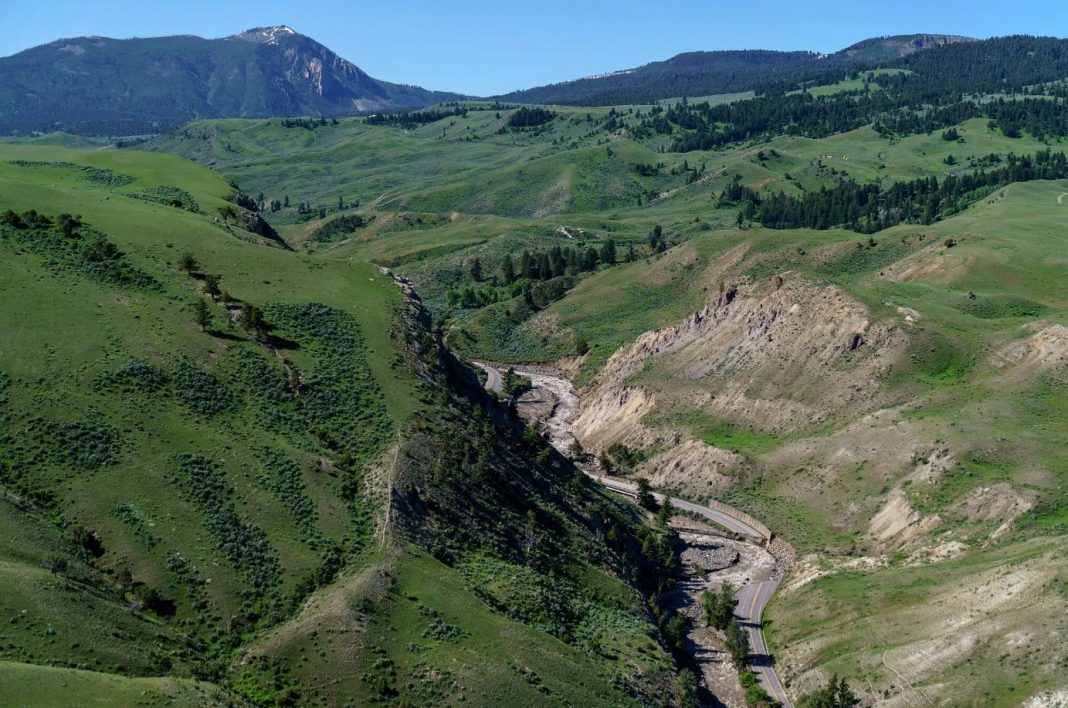After Yellowstone National Park was inundated by floods over the weekend, the menacing dark clouds have dissipated, leaving behind sunlight and bright sky as the park’s namesake river and its tributaries begin to drain. If the weather had been better, tens of thousands of visitors would have visited the nation’s oldest national park this week to begin their summer holidays. However, the park was closed due to inclement weather.
However, as a result of the storm, inhabitants of Yellowstone tourist towns like Gardiner, Montana, are now questioning whether or not they will be able to eke out a livelihood despite the fact that the park’s most popular north gate is currently closed indefinitely. After a pandemic surge in nature tourism, which resulted in Yellowstone setting a record for the number of visitors in 2021, such ideas seemed incomprehensible only a few days ago.
The sole road that connected this town to the park headquarters was completely devastated by the roaring floods, and it was lined with fishing tour firms, restaurants, hotels, and shops that cater to the hundreds of thousands of people that swarm here each summer. It is still unknown when the damaged areas will be repaired; however, the National Park Service has said that the north entrance will likely stay closed until sometime around Halloween.
Gardner is written differently from the town, although both are derived from the name of the same fur trapper. As tourists leave Gardiner to proceed for the park’s interior, they drive on a five-mile, two-lane road that runs along the Gardner River. There is a good chance of seeing bison, bighorn sheep, elk, and pronghorn along this length.
Heavy rain poured on melting snow in Yellowstone’s high country over the past weekend as a consequence of abnormally warm temperatures and an atmospheric river that rushed through the region with a ferocity that residents said was unlike anything they had ever seen before. The Gardner River, which is normally able to be crossed with the throw of a stone, grew into a torrent, converting boulders and logs into wrecking balls that tore big portions of road away.
Officials from Yellowstone National Park were unavailable for comment on Thursday and have not provided a precise estimate for the amount of time needed to repair the road. Scientists have issued a warning that climate change will continue to wreak comparable harm in national parks in the United States for many years to come.
Mr. Parks, whose family company has endured the vicissitudes of Yellowstone weather since 1953, when Mr. Parks’s father first established the store, expressed his concern that some businesses would not be able to make it through the road closure.
Boom-and-bust stories abound in the West, from the California Gold Rush to the Wyoming cattle ranching industry, to name just two examples. The local proprietors of businesses have been through their own own micro cycle in the last several years. In March of 2020, when Covid-19 imposed shutdowns, many people fought desperately to stay alive.
Native Americans, notably members of the Crow tribe, resided in this area until the middle to late 1800s, when they were relocated to reservations against their will. In 1872, Yellowstone was designated as the first national park in the United States, and shortly afterwards, a hotel, restaurant, and several other facilities were constructed with a view of Yellowstone’s towering peaks. After the train reached this area in 1902, Gardiner quickly became a popular starting place for exploration trips.
An unorganised region with several streets that are barely one or two blocks long, Gardiner is located near the mountain-ringed entry to the park. Gardiner is a concentration of homes and businesses. Yellowstone River may be seen winding its way through the heart of town.
For a very long time, Gardiner had the appearance of a desolate outpost with run-down buildings and deteriorating roadways. However, in the most recent couple of decades, new enterprises have come up, and the overall atmosphere of the town is one of increased prosperity. The new high school’s football field is frequented by wild bison, and occasionally they cluster there.
Patrick Sipp, the proprietor of the business, said that the floods had broken the Yellowstone River apart and then reconstructed it in a new manner. Mr. Sipp referred to it as “an whole new river” in his statement. “It’s going to be something that we have to learn all over again.”
In spite of the temporary reprieve, it is possible that the harm may not be completely repaired. This next weekend is predicted to have higher temperatures and rain, both of which might result in an increase in the amount of water flowing through the area.

